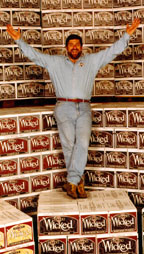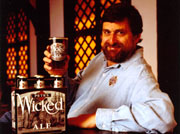The Start of Pete’s Brewing

For about seven years Pete worked at Rolm, and pursued his beer brewing hobby at home. “I never thought or had the intention for this to be a commercial venture up to this point in time.” Rolm’s vacation policy allowed Pete to seriously consider, and ultimately, to start Pete’s Brewing. According to Pete, one of the benefits at Rolm is a 12 week paid sabbatical that every 7 year employee receives in addition to their vacation. His 7th year began in 1985, and he decided to take his sabbatical and vacation (4 months in total) starting in October. His wife was also working, but she could only take eight weeks off. The couple used this time to take two one month-long trips to Europe and South America.
In between his traveling, his friend and former co-worker at Rolm, Mark Bronder, came over, and talked about the many business plans he receives every day at his venture capital job. During this conversation, Mark told Pete that they should be able to dream up a company. They agreed it would be a great idea. “We had to decide what that new company would be. We did not have making beer as the original concept from the very beginning. We had the concept of making a company only.”
They asked themselves :What do we want to do?
- We want to make a world class product whatever it was.
- We want to have fun doing it.
- We want to get involved in a business area or business segment that was at its ground floor and in its infancy.
As the discussion proceeded, they touched on micro brewing. Interestingly enough Mark did not drink; but he was aware of Anchor Brewing and Sierra Nevada which were brew pubs in their area. Pete certainly knew them, and he knew that people would bring back these great beers to their homes and to parties. “It was the start of the analog of wines 15 years earlier when people would have wine parties and bring various wines and get together to talk about them. The set of people that I was involved with were beer geeks. I would travel around with beer and when people were exposed to these beers that had what I called color, taste and aroma they get turned on to it.”
“At that time there were probably two dozen brew pubs and micro breweries around the country, and we saw the potential for big, big growth.” After further planning, the duo decided that they would use this opportunity to brew a really good beer. Mark developed the next piece of their strategy, “He said let’s come up with a great beer, a great name, and an interesting label. Have the name and the label to get people to try it for the first time, and a great beer so they keep coming back.”
When Pete reflected upon his career at Rolm, he truly liked his job and wasn’t looking to leave and start his own company. “When you are on a sabbatical you start to wonder while you are relaxing do you want to bust your buns 80 hours a week for a big company or do something else?” According to Pete, at least half of the people at Rolm who went sabbatical never returned. A good percentage started their own companies.
Mark created the business plan, and while researching their industry, they learned about “excess capacity.” “Breweries weren’t operating at capacity.” When the time came to raise money, they had the option of raising millions of dollars to build their own brewery, or to lease out space at other existing breweries. Pete telephoned Palo Alto Brewing, five miles from his home, and asked if they could lease the facility when it wasn’t in use. “The owner said absolutely and this immediately minimized our initial capital needs.” Their initial seed money came mostly from Pete and Mark, with the remainder from a couple of friends.
Pete chose to brew an English Brown Ale because at the time it was his favorite type of beer that he was brewing at home. This would help to prove how micro brews would be a tasteful alternative to the lighter colored and watery tasting beers from this large brewers – Bud, Miller, and Coors. “I didn’t know what beer to come up with first. So I decided that just in case we don’t make it, I want to brew a beer so I could take it home and drink it!” Also, English Brown Ale was his favorite beer at the time. He tried to copy the ale four times at Palo Alto Brewing . When people tested the beer, only 50% of them liked it, every time. “It was that way for each of the four tries so at that time I realized I would not be able to satisfy everybody. That’s okay. That’s why Budweiser is out there.” On the fourth try, he realized he had something even better than the original recipe he was trying to copy. He said, “Forget the experimentation, this is the best thing I have ever tasted. Let’s go for it.”
The other key element to their strategy was, “We believed we needed to have customers get behind the company.” They saw how people endorsed Ben & Jerry’s Ice Cream and Mrs. Field’s cookies. “We wanted to put our names on it not because of ego but because consumer’s like getting behind real people.” Mark said to Pete that since he doesn’t drink and that Pete’s the brewer, could they just put Pete’s name on it? “Twist my arm. We wanted to have fun with it and we wanted to have fun with an attitude. Wicked Ale is a dark beer, a brown ale. We looked for an adjective to describe the beer. One day Mark heard a comedian on a radio station that used ‘wicked’ in his act and we talked about it afterwards and fell in love with it.”
The Growth of a Legend

From the start of Pete’s sabbatical to the first sale of Pete’s Wicked Ale, it was a little over one year. The first Pete’s was shipped in December, 1986. According to Pete, as soon as they got their first product out they received great consumer feedback about their product and name. The original label was purple with a picture of Pete’s white dog named Millie. It that stood out on the shelf. Word of mouth spread very quickly about the beer. At the time, Pete’s was only legally sold in the San Francisco Bay area. Any sales or transportation of the beer outside this area was illegal. But consumer demand for the beer expanded beyond Palo Alto. Pete remembers one particular story attesting to the beer’s growing popularity. “When traveling for Rolm to Washington, DC once, I went to a popular micro brewery and met the owner to introduce myself and to give a him a six-pack of the beer and a t-shirt. The owner took me over to the cooler to show me that he already was serving Pete’s even though it was only legally being sold in the Bay Area.”
They entered Pete’s Wicked Ale in the Great American Beer festival in 1987, and earned a silver medal. Not only was this event a professional success, but it also indicated the strong customer loyalty the company had. “We did not have enough money for both of us to go so only I went. We didn’t have any give-a-ways or promotional freebies so we used our Millie bottle caps. When I uncapped a bottle I would give away the bottle cap. I was there by myself and when they opened the doors the first 20 people on line came running over to my booth. That pretty much blew my mind away.”
Pete and Mark were both working on the venture part time, but they knew the segment would eventually prosper. They agreed that their goal would be to get into the top three as quickly as possible. Ordering materials, shipping and collecting receivables were all being done after hours. They decided to hire a full time person with sales and distribution experience to run the various facets of the business.
Pete was working full-time for Rolm and part-time for Pete’s. He was doing all the beer festivals and talking about beers. “I had great jobs and had a lot of traveling with my jobs at Rolm. My management was real cool because there was no issue as to whether or not I was spending enough time at Rolm.” He was spending at least 60 hours a week there. “They were cool because I could pretty much pick my travel schedule and it was okay for me to be in a city the same time as a beer festival so I could attend it.” Sometimes his boss would come with him on business trips just to attend the beer festivals.

